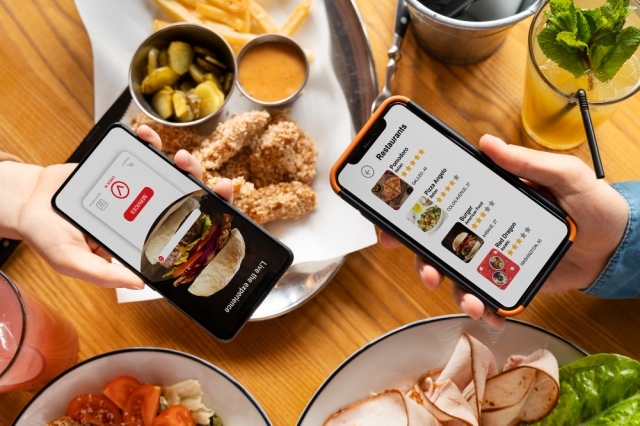As food businesses grow, new challenges often come from within. What worked for a single location or a small customer base starts to strain under volume. Orders get delayed. Inventory runs out. Staff communication falters. Customers leave.
These are not signs of failure, they're signs of growth without the right systems in place. Custom food apps offer a direct way to address these bottlenecks by improving how operations run behind the scenes. They're not just customer-facing tools. When built right, they help growing brands function more smoothly at every level.
1. Order Management Gets Overwhelmed Without Control
When a business starts handling more orders each day, accuracy becomes harder to maintain. Manual entry increases the chance of mistakes. Orders can slip through the cracks. Kitchens get overwhelmed. And customers notice.
A custom app organizes the order flow from start to finish. Orders placed through the app can be routed directly to kitchen staff, with no double entry. Menus update in real time. Availability adjusts based on prep load or inventory. This level of control helps prevent errors and speeds up service, especially during peak hours.
2. Manual Inventory Tracking Slows the Whole Operation
Inventory is the backbone of a food business. Without real-time visibility, it becomes easy to overstock, understock, or miss spoilage dates. When teams rely on spreadsheets or paper logs, small errors can quickly lead to big losses.
With custom food app development, you can get your operational workflows automated to monitor stock levels across multiple locations and trigger alerts when items run low. It can link purchasing with actual usage data. This reduces waste and helps avoid those last-minute scrambles to find ingredients. For businesses with perishable goods, this can be the difference between profit and loss.
3. Communication Between Staff and Departments Breaks Down
In fast-paced environments, verbal updates and paper notes aren't enough. Front-of-house might not know about a kitchen delay. Drivers may leave without the full order. Managers might miss a key issue until it's too late.
An internal app can solve this by enabling real-time updates across roles. Staff can receive tasks, flag issues, and check off steps as they go. Managers get a clear view of what's happening without having to chase updates. This reduces confusion and helps teams focus on service, not firefighting.
4. Customers Drop Off When Experience Is Inconsistent
Customers expect fast, easy, and clear interactions. If an app is hard to navigate or orders take too long, they move on. Many growing food brands lose repeat customers simply because their digital experience doesn't match their product quality.
A custom-built app gives control over the full customer journey. You can simplify checkout, offer saved preferences, and send updates when orders are ready. Loyalty programs and push notifications can drive return visits. Most importantly, the experience stays consistent, whether customers visit in person, order online, or use delivery.
5. Data Stays Scattered Without Integration
Disjointed tools cause more problems than they solve. One system might manage orders. Another tracks deliveries. A third handles marketing. When these tools don't talk to each other, data becomes fragmented, and decisions rely on guesswork.
A custom food app can tie all these parts together. It can pull from your POS, sync with your ERP, and give real-time dashboards that reflect how the business is actually performing. This visibility makes it easier to plan ahead, adjust pricing, and spot trends before they become problems.
6. Speed of Service Starts to Decline
As volume increases, so does the chance of delays. Delivery windows tighten. Prep times increase. Teams feel the pressure. Without support, speed suffers, and customers begin to notice. Custom apps can introduce features like driver tracking, automated dispatching, or customer ETA notifications. Kitchens can see order times and delivery deadlines in one place. This level of visibility helps reduce stress on the team and gives customers more confidence in your service.
7. Compliance and Quality Control Fall Through the Cracks
Food safety doesn't scale on good intentions alone. With more locations or product lines, the risk of missing a step increases. Forgotten temperature checks, missed expiry dates, or skipped cleanings can put your business at risk.
Custom apps make quality control easier to track. You can build in digital checklists, log time-stamped tasks, and enforce critical controls like allergen warnings or sanitation cycles. This creates a clear trail of compliance and helps protect your brand reputation.
How Folio3 FoodTech Builds Apps That Solve These Bottlenecks
At Folio3 FoodTech, we specialize in custom food app development services tailored to real operational challenges. Our work spans food delivery platforms, supply chain tracking, and D2C ordering apps. But what ties it all together is a focus on removing friction.
We build apps that sync inventory across channels. We develop tools that give staff clarity, not complexity. We help brands reduce order errors, speed up service, and manage customer relationships in one place.
Whether it's connecting your app to your ERP or creating a mobile-friendly way for franchisees to update menus, our solutions are built around your workflow. Our goal is simple: to help food brands grow without getting stuck in operational slowdowns.
Conclusion
Growth should be exciting. But without the right tools, it turns into stress, delays, and confusion. Bottlenecks are not just about getting bigger. They are a sign your systems can no longer keep up.Custom food apps help fix that. They bring clarity, speed, and better control to daily operations. With the right app, you do not just stay on track. You move forward faster.
If your team is feeling the pressure, it may be time to change how you work. A custom food app could be the fix you have been needing.






